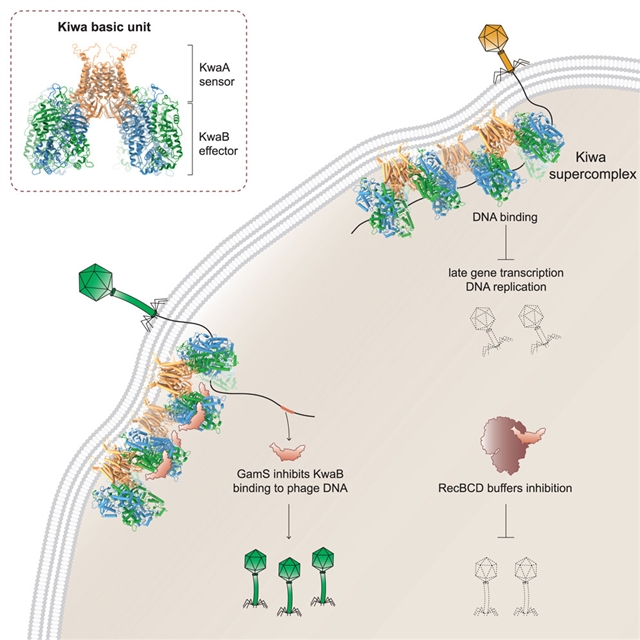
英国南安普顿大学Franklin L. Nobrega研究组揭示了Kiwa是一种在噬菌体附着位点激活的膜内防御超复合体。2025年7月28日出版的《细胞》发表了这项成果。
Kiwa是一种广泛存在的双组分系统,由跨膜传感器KwaA和dna结合效应物KwaB组成。低温电子显微镜(cryo-EM)分析显示,KwaA和KwaB组装成一个大的,膜相关的超复合物。在噬菌体结合后,KwaA在膜上感知感染,导致KwaB结合喷出的噬菌体DNA,抑制复制和晚期转录,而不诱导宿主细胞死亡。虽然KwaB可以独立结合DNA,但其抗病毒活性需要与KwaA结合,提示存在空间或构象调控。该研究团队发现噬菌体编码的DNA模拟蛋白Gam直接结合并抑制KwaB,但与Gam靶向的RecBCD系统共表达可以恢复Kiwa的保护作用。他们的发现支持Kiwa协调噬菌体感染的膜相关检测与下游DNA的效应结合的模型,形成一个空间协调的抗病毒机制。
据悉,细菌和古细菌部署不同的抗病毒防御系统,其中许多仍然没有机械特征。
附:英文原文
Title: Kiwa is a membrane-embedded defense supercomplex activated at phage attachment sites
Author: Zhiying Zhang, Thomas C. Todeschini, Yi Wu, Roman Kogay, Ameena Naji, Joaquin Cardenas Rodriguez, Rupavidhya Mondi, Daniel Kaganovich, David W. Taylor, Jack P.K. Bravo, Marianna Teplova, Triana Amen, Eugene V. Koonin, Dinshaw J. Patel, Franklin L. Nobrega
Issue&Volume: 2025-07-28
Abstract: Bacteria and archaea deploy diverse antiviral defense systems, many of which remain mechanistically uncharacterized. Here, we characterize Kiwa, a widespread two-component system composed of the transmembrane sensor KwaA and the DNA-binding effector KwaB. Cryogenic electron microscopy (cryo-EM) analysis reveals that KwaA and KwaB assemble into a large, membrane-associated supercomplex. Upon phage binding, KwaA senses infection at the membrane, leading to KwaB binding of ejected phage DNA and inhibition of replication and late transcription, without inducing host cell death. Although KwaB can bind DNA independently, its antiviral activity requires association with KwaA, suggesting spatial or conformational regulation. We show that the phage-encoded DNA-mimic protein Gam directly binds and inhibits KwaB but that co-expression with the Gam-targeted RecBCD system restores protection by Kiwa. Our findings support a model in which Kiwa coordinates membrane-associated detection of phage infection with downstream DNA binding by its effector, forming a spatially coordinated antiviral mechanism.
DOI: 10.1016/j.cell.2025.07.002
Source: https://www.cell.com/cell/abstract/S0092-8674(25)00791-3
